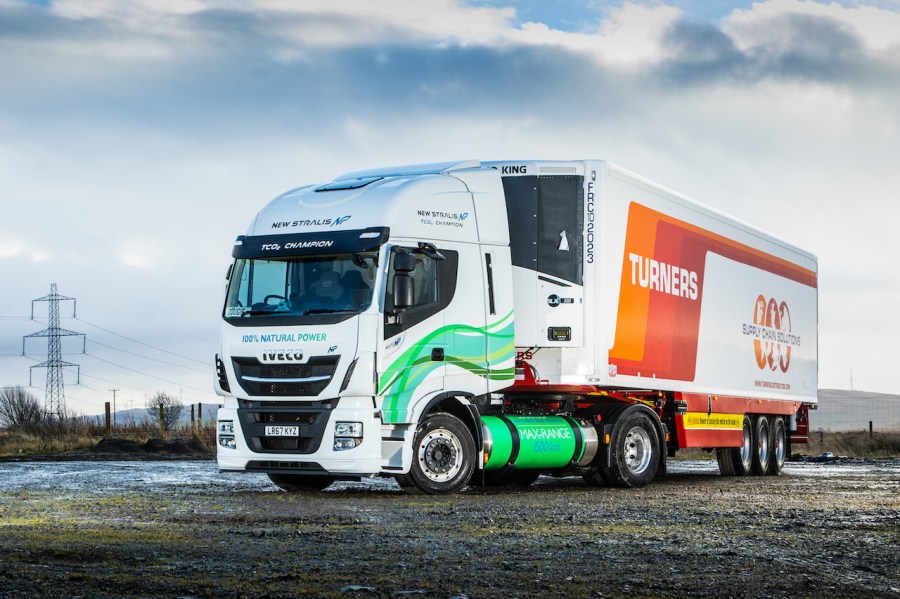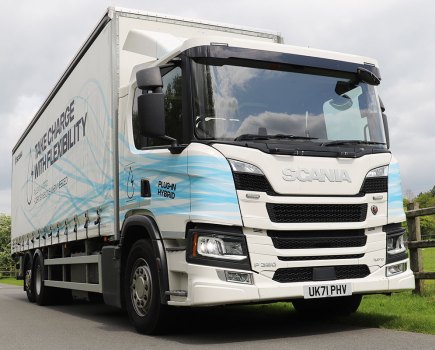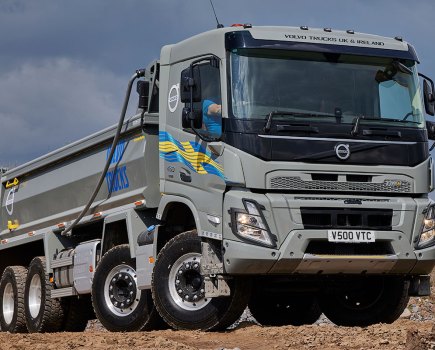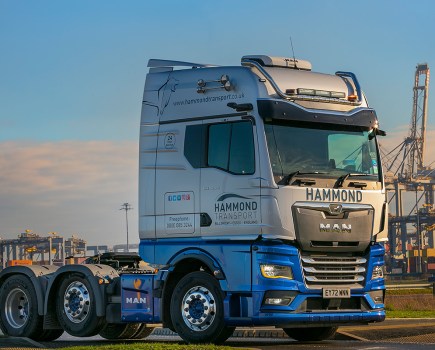We spent two weeks at work with an Iveco Stralis NP, which runs purely on liquified natural gas (LNG). A genuine alternative to diesel is here.
Iveco is at the forefront of gas-powered truck technology. Last year, it laid on a road test from John O’Groats to Land’s End for members of the press (ourselves included) to try out its new 100 per cent LNG Stralis. We were then granted the opportunity to put one to work for two weeks.
The Stralis NP comes in 4×2 spec only for now, due to the space the tanks take up on the chassis. (A 6×2 version is coming later this year, though with smaller tanks and shorter operational range between fills.) In any case, the 4×2 model is powered by a modest 8.7-litre engine producing 400 bhp and 1700 Nm of torque, so it’s not really suitable for 44-tonne operations.
But then, not every haulier is involved with moving heavy freight. I’ve been working for GBT of Lesmahagow since last June, and much of the freight it moves doesn’t weigh much, but goes long distance. Meaning of course that the Stralis NP could be ideally suited for its operations.
On brand
My daily workhorse over the past few months has been an old Stralis, and I’ve really grown to like it. The dash layout and driving position are excellent. However, the interior trim isn’t the best and it’s not what you’d call pretty.
The new Stralis is a vast improvement: all the good stuff from the old model is retained, but it’s packaged in a much nicer way. Classy black soft-touch trim and luxurious seats are the order of the day, with the NP being reasonably well spec’d as standard. One thing to note about these early NPs is they retain some features from older models. A new diesel Stralis will have an updated computer display, LED lights, driver coaching functions and the new Hi-Tronix transmission. Our 400 NP has none of these, due to the gas technology being in Research and Development for so long that the latest updates passed it by.
It runs the old Eurotronic gearbox which in this application is crude when compared to any diesel Stralis (even my old 55-plate). Iveco wasn’t able to make the gas engine and auto ’box work well together for some reason. The new 460 NP version and subsequent 400s run the new Hi-Tronix gearbox and is said to be much smoother – it’s going to have to be (it is – ed). The pure LNG engine is bold new technology; it’s the job of these first trucks to plant seeds, but if you put a driver of any Euro 6 diesel auto into one, the first thing they’ll go on about is the gearbox and we’re concerned it could overshadow the many positives. There aren’t many of these early trucks in the UK, so if you get the opportunity to try one, keep an open mind.
It’s impossible to manoeuvre smoothly, no matter how light your touch on the throttle is. Hooking into, or parking trailers can be a pantomime as the truck refuses to move until your foot is almost on the floor, then it’ll surge forward (or backward) suddenly. Pulling away smoothly in traffic is impossible too. I had to navigate Aberdeen’s many roundabouts in rush hour and the only way I could do so was simply to floor the throttle and accept the wheelspin. Using the stalk to change manually achieves only limited results, with a double pull/push often not providing a double shift. It’s the most crude auto ’box I’ve encountered on a modern truck.
Against the odds
Now we’ve got that out the way, here’s a surprise; in spite of the poor gearbox, the Stralis NP is still fantastic. Most of the time trucks of this nature will be used on trunk operations, racking up the miles on the motorway, and once you’re into 12th, the gearbox no longer matters. The engine differs from a diesel in that it’s quieter and smoother. It actually uses spark plugs to ignite the gas instead of compression. The power band is higher, so you’ll be using the revs more, but it’s not a problem as it’s so sweet – and on the open road, everything falls into place.
Fuelling up is a bit more complicated than with a diesel, but it’s no big deal. We had organised with BOC Gases to use its new facility at Exelby Services in Carlisle. In fact, we were the first truck to ever use it! You open the cover on the gas tank, hook up an earth, a vent pipe and the gas supply pipe – having first used a compressed airline to remove any moisture. Then you simply use a fob and keypad to activate the pump. Gassing takes about five minutes. It’s essential to use the correct PPE; thermal gloves and a face shield, plus making sure your arms and legs are covered. Liquified natural gas is supplied at a freezing temperature, so you don’t want to get any on you.
The twin tanks hold enough gas for a range of up to 1500 km. There aren’t many suitable LNG gas stations around at the moment, which is one of the challenges facing LNG to begin with. Operators can opt to have a tank installed on their premises, though. BOC arranged for the truck to be fuelled at Eddie Stobart’s depot near Warrington as necessary, which was a big help. Stobart’s currently runs a fleet of duel-fuel LNG-diesel Scanias.
Green running
Once you’re out on the road, you’d be hard-pushed to tell the difference between gas and diesel. One of my regular jobs during the two weeks I had with the truck was taking a curtainsider load of polystyrene packaging from Scotland down to Merseyside. High volume, low weight; perfect. I’d then go and collect a load of cladding from Kingspan in North Wales and take it back north.
It was soon clear that wherever I took the Stralis NP, people would ask about it. Drivers’ thoughts were mixed: some were curious, others were cynical and others just plain silly (“We had one of those and it exploded!” No, you didn’t). Many were of the opinion diesel power has peaked. It wasn’t just drivers though; being seen to be green with people outside the transport industry is probably one of the most positive things you can do for your company image.
After a couple of days, I was right at home behind the wheel. The NP comes equipped with a Voith retarder which is very powerful – far more so than the standard Stralis engine brake. Once you have it sussed, you can be much lighter with the brake pedal, which in typical Iveco fashion is quite hard. I was sent up into Aberdeenshire with a Moffett forklift to self-tip a load, and from there I had to reload with Christmas trees. It turned out the site was running way behind schedule so I ended up spending the night there, and most of the following morning. The night heater has a small diesel tank, and it was almost empty by the time I got moving. Stiff mattress aside, the Hi-Way was a perfectly comfortable place to be parked up.
A full load of trees plus the Moffett equated to around 12 tonnes, and the NP coped with it fine. It’s comfortable around that weight, and my run up north and back gave a fuel return of 11.2 mpg according to the dash, which presumably is working that figure out in comparison to a gallon of diesel. In any case, the quoted range of 1500 km is perfectly viable. The truck is plated to 40 tonnes, but I suspect hauling weight above the low 30 tonnes will be a bit hard on it.
My last job with the Stralis was to collect a brand-new fridge trailer from Gray & Adams in Fraserburgh and deliver it to Turner Distribution’s depot at Newmarket, before returning the truck to Iveco in Dunstable. It doesn’t get much easier than that. I’d really got to like the NP over the two weeks. GBT liked it so much it opted to buy two of them, which is as high an accolade you can pay a demonstrator.
VERDICT
By the end of the fortnight, I was completely at home in the Stralis NP. The gearbox is disappointing, but the engine is silky smooth and powerful for a small capacity. I reckon the Stralis range as a whole is very under-rated as a driver’s truck; the NP steers and handles very well and there’s a lot of thought gone into the interior design. In terms of reliability, the truck was faultless, with not so much as a single warning appearing on the dash. One of the greatest advantages an LNG truck has over a diesel (aside from the cheaper cost of fuel) is it doesn’t need complex AdBlue and EGR equipment, both of which often prove to be unreliable and costly to fix. Fuelling is quick and simple. If Iveco can back these up through the dealerships and the likes of BOC can expand the fuelling infrastructure, then we are 100 per cent looking at a viable low-emission alternative to diesel.
More information: https://www.iveco.com/uk






